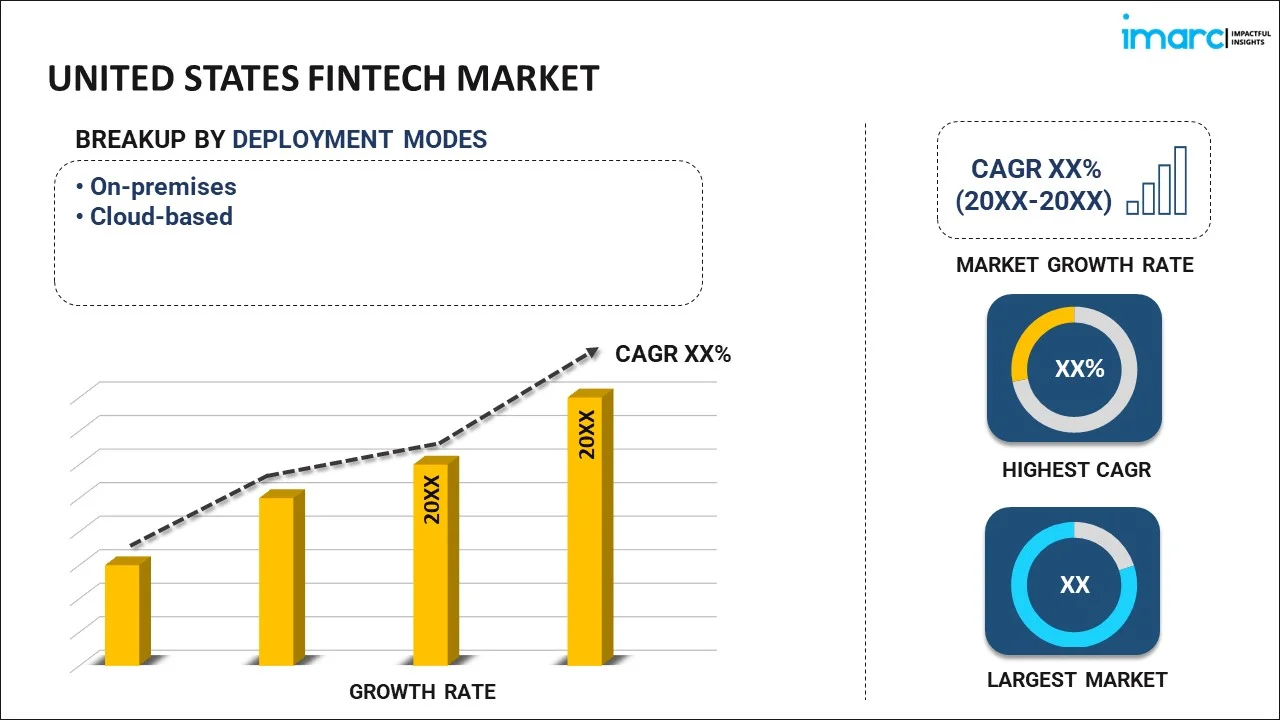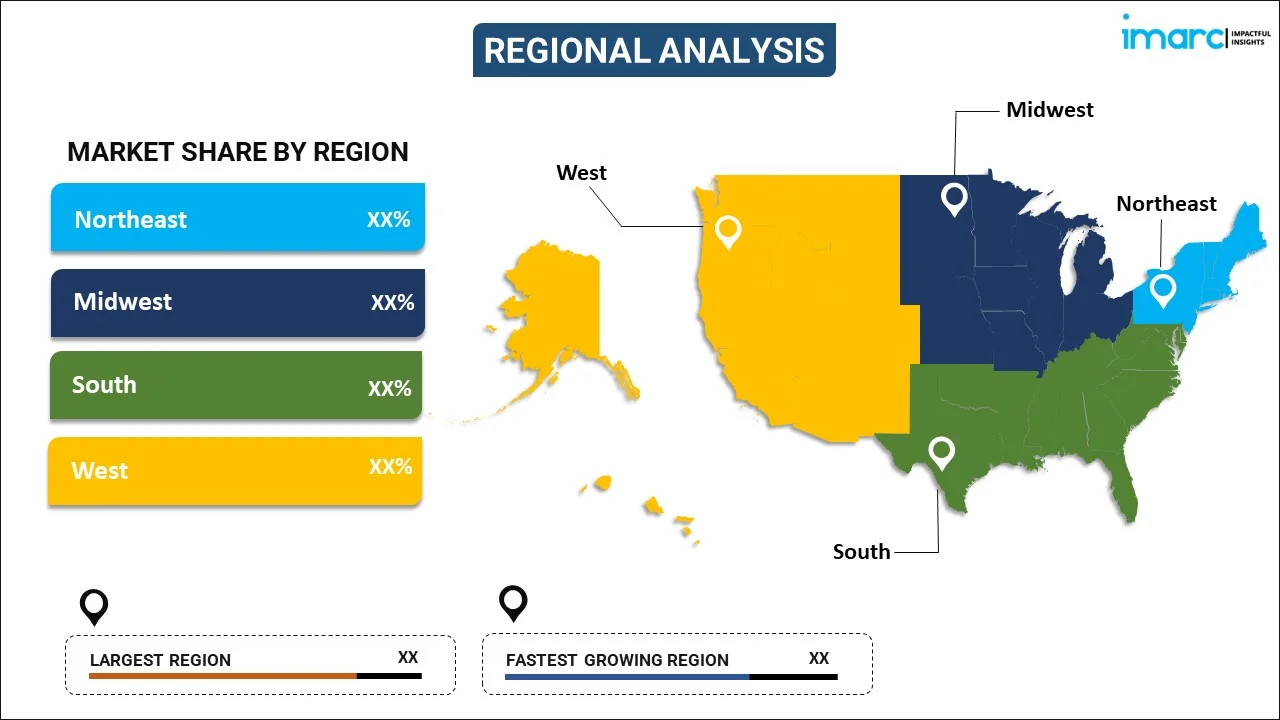
United States Fintech Market Report by Deployment Mode (On-premises, Cloud-based), Technology (Application Programming Interface, Artificial Intelligence, Blockchain, Robotic Process Automation, Data Analytics, and Others), Application (Payment and Fund Transfer, Loans, Insurance and Personal Finance, Wealth Management, and Others), End User (Banking, Insurance, Securities, and Others), and Region 2025-2033
Market Overview:
The United States fintech market size reached USD 53.0 Billion in 2024. Looking forward, IMARC Group expects the market to reach USD 181.6 Billion by 2033, exhibiting a growth rate (CAGR) of 13.9% during 2025-2033. The growing demand for convenient and user-friendly financial services, increasing development of innovative platforms for payments, lending, wealth management, and insurance, and rising emergence of decentralized finance (DeFi) represent some of the key factors driving the market.
|
Report Attribute
|
Key Statistics
|
|---|---|
|
Base Year
|
2024 |
|
Forecast Years
|
2025-2033
|
|
Historical Years
|
2019-2024
|
| Market Size in 2024 | USD 53.0 Billion |
| Market Forecast in 2033 | USD 181.6 Billion |
| Market Growth Rate (2025-2033) | 13.9% |
United States Fintech Market Analysis:
- Key Market Drivers: Accelerated digitalization, penetration of smartphones, and aspirations for smooth financial experiences are driving innovation. Favorable regulatory policies and innovations in technologies such as AI and blockchain are prompting financial institutions and technology startups to provide integrated, user-friendly financial services on various platforms, propelling United States fintech market share.
- Key Market Trends: The industry is seeing rising uptake of embedded finance, automation, and decentralized protocols. Customers are drawn to mobile-first offerings with tailored insights, as fintech platforms mature to bring lending, payments, and investment functionality into integrated, accessible digital ecosystems across diverse user segments.
- Competitive Landscape: Participants in the market consist of a combination of legacy banks, technology providers, and digital-native companies. Fierce competition is centered on service personalization, user acquisition, and innovation, with the players using cloud infrastructure, user interfaces, and data analytics to differentiate their offerings and maintain their market share.
- Challenges and Opportunities: As per the United States fintech market, cybersecurity issues, regulatory and supervisory requirements, and data protection challenges pose a challenge to growth. Nevertheless, increasing access to finance, need for real-time services, and innovations in the infrastructure present considerable opportunities for scalable, inclusive, and technologically enabled financial solutions in both consumer and business segments.
Financial technology (Fintech) refers to the innovative employment of technology to enhance and automate various financial services and processes. It comprises a wide array of applications that aim to improve efficiency, accessibility, and convenience in financial transactions and services. It encompasses the development of cryptocurrencies, such as Bitcoin, and platforms built on blockchain technology. It relies on data analytics and alternative data sources to assess creditworthiness and streamline the lending process. Fintech spurs innovation by introducing new ways of managing finances, investing, and transacting. It enables the development of digital payment platforms and mobile wallets that enable users to make payments, transfer funds, and even split bills easily and securely. It facilitates the sharing of financial data securely between different financial institutions, allowing users to have a more comprehensive view of their finances and enabling third-party developers to create new services. It also helps users track their expenses, set budgets, and manage their overall financial health via an application. It enables financial institutions to comply with regulations more efficiently through automation, data analysis, and reporting tools. Furthermore, as it transforms trading by enabling algorithms to execute trades based on predefined criteria, often improving efficiency, and reducing human bias, the demand for fintech is rising in the United States.
United States Fintech Market Trends:
Expansion of the Digital Banking Ecosystem
One of the most significant trends in the financial technology industry is the increasing consolidation of services into digital banking platforms. Concurrently, consumers expect end-to-end, mobile-centric solutions that allow for banking, investing, payments, and budgeting within a single cohesive interface. This change is fueling a platform interoperability surge, with fintech providers using APIs and cloud-based platforms to enrich customer experiences. Moreover, embedded finance integration enables non-financial platforms to provide banking services, further making digital financial services more accessible. Customized financial management tools are also becoming the norm, leveraging user behavior data to provide customized insights. These follow the ongoing shifts in user preferences and financial behaviors. The focus on platform efficiency, transparency, and personalization plays a key role in United States fintech market growth, cementing the digital banking position in daily financial activities.
Rise of AI-Powered Financial Intelligence
Artificial intelligence becomes increasingly pivotal to U.S. fintech product and service development. From robo-advisory to anti-fraud activities, AI algorithms are improving real-time decision-making, predictive analytics, and customer personalization. Fintech offerings are employing machine learning to make better credit risk decisions, streamline back-end functions, and provide smart money advice. As per the sources, in April 2024, Ushur released an AI-driven self-service platform to make Know Your Customer (KYC) and paperless enrollment automated, allowing financial institutions to grow compliance, minimize manual effort, and provide secure, omnichannel digital engagement at scale. Moreover, natural language processing capabilities are also becoming increasingly popular for enhancing chatbot interfaces and customer service automation. As these technologies evolve, they are finding applications in multiple segments of financial services such as lending, wealth management, and insurance. This shift aligns with shifting consumer demands for easy, efficient service delivery. The use of advanced analytics is influencing emerging consumer behavior and enhancing operational resilience. The innovations underscore a primary direction among United States fintech market trends, with AI-based systems revolutionizing the way institutions and customers interact with financial information.
Integration of Decentralized Finance Technologies
Decentralized Finance (DeFi) has proven to be a revolutionary driver in the American fintech landscape, providing peer-to-peer transactions without the need for traditional intermediaries. Established on blockchain networks, DeFi platforms extend programmable, open financial services such as lending, yield farming, and decentralized exchanges. This transformation is leading fintech companies to embrace hybrid models that integrate the convenience of centralized interfaces and the independence of decentralized protocols. Tokenized assets and smart contracts are used for greater efficiency, real-time settlement, and cost savings. As regulatory clarity enhances, increasing numbers of institutional participants are considering DeFi-enabled offerings to diversify product lines and enhance capital efficiency. These developments represent a larger shift in the way that financial services are framed and brought to market. Blockchain-based finance's expanding footprint is a very good leading indicator of market trends, reflecting the trend toward more inclusive, trustless, and programmable financial architectures.
United States Fintech Market Segmentation:
IMARC Group provides an analysis of the key trends in each segment of the United States fintech market report, along with forecasts at country level for 2025-2033. Our report has categorized the market based on deployment mode, technology, application, and end user.
Deployment Mode Insights:

To get more information on this market, Request Sample
- On-premises
- Cloud-based
The report has provided a detailed breakup and analysis of the market based on the deployment mode. This includes on-premises and cloud-based.
Technology Insights:
- Application Programming Interface
- Artificial Intelligence
- Blockchain
- Robotic Process Automation
- Data Analytics
- Others
A detailed breakup and analysis of the market based on the technology has also been provided in the report. This includes application programming interface, artificial intelligence, blockchain, robotic process automation, data analytics, and others.
Application Insights:
- Payment and Fund Transfer
- Loans
- Insurance and Personal Finance
- Wealth Management
- Others
A detailed breakup and analysis of the market based on the application has also been provided in the report. This includes payment and fund transfer, loans, insurance and personal finance, wealth management, and others.
End User Insights:
- Banking
- Insurance
- Securities
- Others
A detailed breakup and analysis of the market based on the end user has also been provided in the report. This includes banking, insurance, securities, and others.
Regional Insights:

- Northeast
- Midwest
- South
- West
The report has also provided a comprehensive analysis of all the major regional markets, which include Northeast, Midwest, South, and West.
Competitive Landscape:
The report has also provided a comprehensive analysis of the competitive landscape in the market. Competitive analysis such as market structure, key player positioning, top winning strategies, competitive dashboard, and company evaluation quadrant has been covered in the report. Also, detailed profiles of all major companies have been provided.
Latest News and Developments:
- In January 2025, Trump Media and Technology Group made the announcement in January 2025 that its fintech brand, Truth.Fi, would launch and provide investments in ETFs, SMAs, Bitcoin, and cryptocurrencies. The services will be launched later in 2025 subject to regulatory approval with a $250 million funding support.
- In July 2024, the launch of Miami-based wealthtech start-up Waltz, which now offers a digital platform to facilitate foreign buyers buying US residential property in just 30 days. The platform simplifies LLC setup, online banking, and access to mortgages, and has operations across nine states with an expansion planned in Arizona.
United States Fintech Market Report Coverage:
| Report Features | Details |
|---|---|
| Base Year of the Analysis | 2024 |
| Historical Period | 2019-2024 |
| Forecast Period | 2025-2033 |
| Units | Billion USD |
| Scope of the Report | Exploration of Historical and Forecast Trends, Industry Catalysts and Challenges, Segment-Wise Historical and Predictive Market Assessment:
|
| Deployment Modes Covered | On-premises, Cloud-based |
| Technologies Covered | Application Programming Interface, Artificial Intelligence, Blockchain, Robotic Process Automation, Data Analytics, Others |
| Applications Covered | Payment and Fund Transfer, Loans, Insurance and Personal Finance, Wealth Management, Others |
| End Users Covered | Banking, Insurance, Securities, Others |
| Regions Covered | Northeast, Midwest, South, West |
| Customization Scope | 10% Free Customization |
| Post-Sale Analyst Support | 10-12 Weeks |
| Delivery Format | PDF and Excel through Email (We can also provide the editable version of the report in PPT/Word format on special request) |
Key Benefits for Stakeholders:
- IMARC’s report offers a comprehensive quantitative analysis of various market segments, historical and current market trends, market forecasts, and dynamics of the United States fintech market from 2019-2033.
- The research study provides the latest information on the market drivers, challenges, and opportunities in the United States fintech market.
- Porter's five forces analysis assist stakeholders in assessing the impact of new entrants, competitive rivalry, supplier power, buyer power, and the threat of substitution. It helps stakeholders to analyze the level of competition within the United States fintech industry and its attractiveness.
- Competitive landscape allows stakeholders to understand their competitive environment and provides an insight into the current positions of key players in the market.
Key Questions Answered in This Report
The fintech market in the United States was valued at USD 53.0 Billion in 2024.
The United States fintech market is projected to exhibit a CAGR of 13.9% during 2025-2033, reaching a value of USD 181.6 Billion by 2033.
Key drivers of the United States fintech industry are growing consumer demand for digital financial services, extensive penetration of smartphones and internet, developments in AI and blockchain technologies, and encouraging regulatory efforts. The pressure to achieve financial inclusion and facilitate real-time transaction capabilities is also speeding up innovation across different fintech segments.
Need more help?
- Speak to our experienced analysts for insights on the current market scenarios.
- Include additional segments and countries to customize the report as per your requirement.
- Gain an unparalleled competitive advantage in your domain by understanding how to utilize the report and positively impacting your operations and revenue.
- For further assistance, please connect with our analysts.
 Request Customization
Request Customization
 Speak to an Analyst
Speak to an Analyst
 Request Brochure
Request Brochure
 Inquire Before Buying
Inquire Before Buying




.webp)




.webp)












